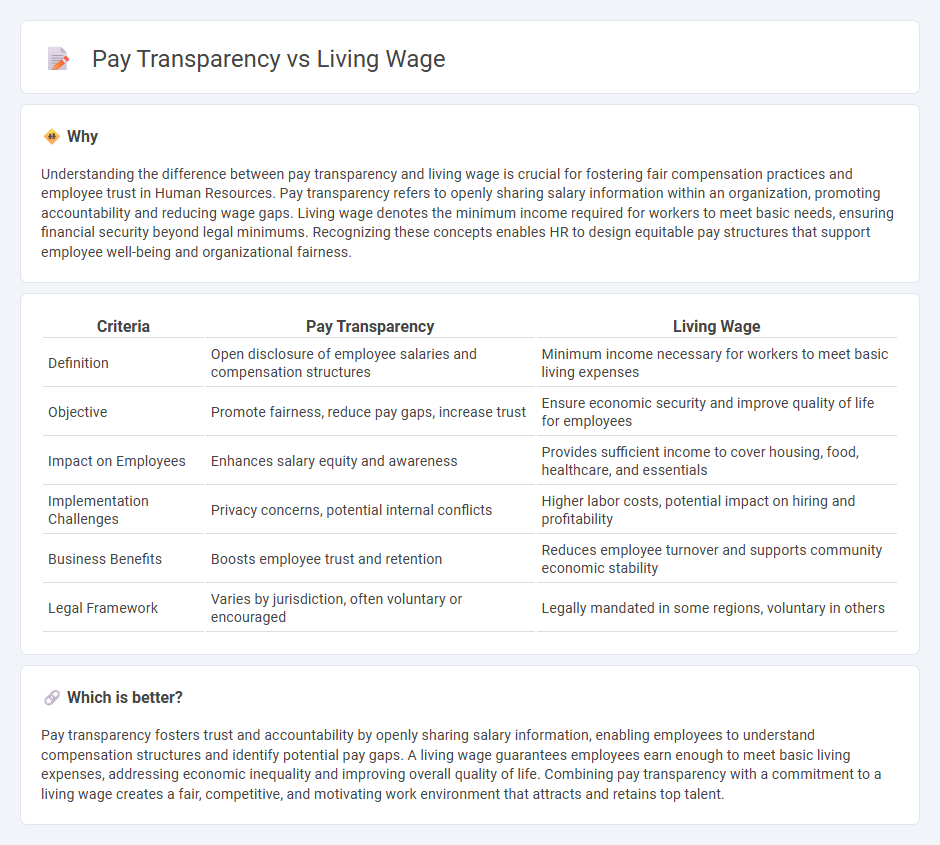
Pay transparency enhances employee trust by openly sharing compensation data, while living wage policies ensure workers earn enough to meet basic living expenses. Organizations adopting both strategies create fairer, more motivated workplaces that attract and retain talent. Explore how integrating pay transparency with living wage commitments can transform your human resources approach.
Why it is important
Understanding the difference between pay transparency and living wage is crucial for fostering fair compensation practices and employee trust in Human Resources. Pay transparency refers to openly sharing salary information within an organization, promoting accountability and reducing wage gaps. Living wage denotes the minimum income required for workers to meet basic needs, ensuring financial security beyond legal minimums. Recognizing these concepts enables HR to design equitable pay structures that support employee well-being and organizational fairness.
Comparison Table
| Criteria | Pay Transparency | Living Wage |
|---|---|---|
| Definition | Open disclosure of employee salaries and compensation structures | Minimum income necessary for workers to meet basic living expenses |
| Objective | Promote fairness, reduce pay gaps, increase trust | Ensure economic security and improve quality of life for employees |
| Impact on Employees | Enhances salary equity and awareness | Provides sufficient income to cover housing, food, healthcare, and essentials |
| Implementation Challenges | Privacy concerns, potential internal conflicts | Higher labor costs, potential impact on hiring and profitability |
| Business Benefits | Boosts employee trust and retention | Reduces employee turnover and supports community economic stability |
| Legal Framework | Varies by jurisdiction, often voluntary or encouraged | Legally mandated in some regions, voluntary in others |
Which is better?
Pay transparency fosters trust and accountability by openly sharing salary information, enabling employees to understand compensation structures and identify potential pay gaps. A living wage guarantees employees earn enough to meet basic living expenses, addressing economic inequality and improving overall quality of life. Combining pay transparency with a commitment to a living wage creates a fair, competitive, and motivating work environment that attracts and retains top talent.
Connection
Pay transparency fosters trust and equity in organizations by openly sharing salary information, which encourages the adoption of a living wage that meets employees' basic needs and local cost of living. Transparent compensation practices help identify and address wage gaps, promoting fair pay structures aligned with living wage standards. This connection drives improved employee satisfaction, retention, and overall workplace equity.
Key Terms
Compensation
Living wage ensures employees receive compensation that meets basic living standards, directly impacting financial well-being and job satisfaction. Pay transparency promotes fairness by openly sharing salary information, reducing wage gaps and fostering trust within organizations. Explore in-depth strategies to balance fair living wages and transparent pay practices for optimal compensation management.
Equity
Living wage initiatives ensure employees earn income that meets basic living standards, addressing economic equity and social justice. Pay transparency promotes fairness by openly sharing salary information, reducing wage gaps and fostering trust within organizations. Explore how integrating living wage policies with pay transparency can advance workplace equity and inclusion.
Disclosure
Living wage policies ensure employees earn enough to meet basic needs, while pay transparency emphasizes openly disclosing salary information within organizations. Disclosure in pay transparency fosters trust, reduces wage gaps, and promotes fairness by making compensation practices visible. Explore more about how effective disclosure strategies can transform workplace equity and employee satisfaction.
Source and External Links
Living Wage Law - NYC.gov - As of April 1, 2025, the living wage rate in New York City is $16.50 per hour, with a health benefit supplement of $2.20, and the state minimum wage now matches this living wage rate.
Living wage - Wikipedia - A living wage is the minimum income necessary for a worker to afford basic needs, differing from a subsistence wage and varying widely by location based on local costs.
What is a Living Wage? - The ILR School - Cornell University - A living wage is defined as the hourly pay required for a full-time worker to meet their basic needs, with estimates calculated using localized data on expenses such as food, housing, childcare, and healthcare.
 dowidth.com
dowidth.com